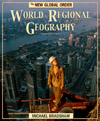 |  World Regional Geography: The New Global Order Update, 2/e Michael Bradshaw,
College of St. Mark and John
Africa South of the Sahara
Chapter OutlineUse this outline to increase your understanding of the important characteristics
of Africa South of the Sahara. - At the Extreme Periphery
-- With little integration into the world economy, this region is the poorest
and has the worst prospects. Culturally, Africa has made significant contributions
in the arts.
- African Cultures -- Even
as African society changes and becomes more modern, tribal loyalties remain
strong. Many conflicts result from tribal differences. Tribal cooperation
is needed for this region to make progress.
- Natural Environment --
This region's environment contains more advantages than is normally believed
to exist.
- Tropical Climates --
High temperatures dominate with some areas lacking adequate and reliable
rainfall.
- Changing Climates --
Caused by natural cycles and/or human activities, arid areas expand and
contract over time.
- Ancient Rocks, Plateaus,
and Rifts -- Plateaus are found throughout the region. River transportation
is hampered by seasonal low water levels and numerous waterfalls and rapids.
- Ancient Landscapes
-- The flat plateau areas are very old and stable.
- Forests, Savannas,
and Deserts -- Tropical rainforests, savanna grasslands, and deserts are
the principal areas. Soils are generally poor.
- Resources -- Aside
from oil and natural gas, this region contains very significant mineral
deposits. In some cases, mineral exploitation is limited by the lack of
development.
- Environmental Problems
-- Declining soil quality, deforestation, overgrazing, and diseases like
HIV/AIDS are the major problems.
- Central Africa -- Dense
rainforest makes this subregion isolated and numerous conflicts hamper progress.
- Countries -- All are
among the poorest countries in the world.
- People -- Although
urban growth is rapid, most of the people still live in rural areas. Population
growth is very fast. Tribal and ethnic rivalries cause political problems
and often lead to conflict.
- Economic Development
-- Development is limited. Agriculture is the main economic activity, but
not enough food is produced to feed the growing population. Mineral exports
are essential, but better transportation is needed. Besides some help from
France, the world economy has little interest in this subregion.
- Western Africa -- This
area is the most populous subregion in Africa South of the Sahara and suffers
from numerous development problems
- Countries -- Except
for Nigeria with about 100 million people, the other 14 countries have small
populations.
- People -- Birth rates
remain high. Cities grow quickly. Muslim trade and colonialism by Britain,
France, and Germany had long lasting effects on this subregion.
- Economic Development
-- Development is less limited than in Central Africa, but fluctuations
in world prices for export products are major concerns. Agriculture is most
important, whereas mining is not so important except for Nigeria's oil.
Government management and political leadership remain concerns.
- Eastern Africa -- Rift
valleys, dryness, and Ethiopia never being colonized are highlights of this
subregion.
- Countries -- These
seven countries vary in several respects.
- People -- Very fast
population growth. Coptic Christians in Ethiopia and Muslims from Southwest
Asia competed for influence in northern parts of this subregion. Southern
areas had fewer migrations and conflicts.
- Economic Development
-- Like other African areas, this subregion is poor with agriculture the
principal activity. Manufacturing and service activities show little development.
- World Issue: Famine in
Africa -- Famines are likely to persist in Africa South of the Sahara. Disruptions
caused by events like drought or civil war to food production and distribution
systems cause famines. Relief efforts are often severely hampered by poor
transportation systems. Chronic hunger is a serious concern.
- Southern Africa -- Led
by the Republic of South Africa, this subregion is the most economically developed.
- Countries -- Mineral
endowment is a major variable among these countries. Apartheid no longer
exists in the Republic of South Africa.
- People -- Population
growth is slowing in some areas. Colonialism had varying impacts throughout
the subregion. The Republic of South Africa is the only area with a significant
number of white people.
- Economic Development
-- Mineral exports are very important. Unlike the rest of Africa South of
the Sahara, the Republic of South Africa has significant manufacturing,
services, and infrastructure.
- Living in Zimbabwe --
Population pressure and drought are making land ownership issues especially
important. In order to help poor people, should the government distribute
lands away from the successful, white-owned commercial farms and disrupt their
production of valuable exports?
- Landscapes in Africa
South of the Sahara -- Contrasts from colonial times between Brazzaville and
Kinshasa are important. Rural landscapes vary from almost undisturbed lands
to growing umbers of villages and small towns.
- Future Prospects -- Prospects
are poor in the short run.
- Legacy -- Based on
patterns established during colonial times, this region sells low priced
primary products to core countries and buys high priced manufactured products
from the core countries. Global warming is potentially a serious problem
for Africa South of the Sahara.
- Disappointments --
Due to a variety of reasons, development has been limited since these countries
have become independent. Conditions have become worse in some areas.
- Basic Needs -- Improvements
in education have been offset by continuing transportation problems.
|
|



 2002 McGraw-Hill Higher Education
2002 McGraw-Hill Higher Education